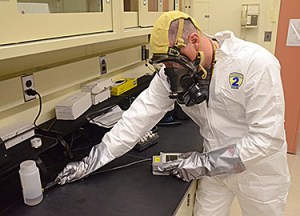Oct 28 2013
When it comes to detectors for dangerous chemicals, toxins or nefarious germs, smaller and faster is better. But size and speed must still allow for accuracy, especially when measurements by different instruments must give the same result.
 Christopher Neary of the NIST Environmental Management Group demonstrates the use of a handheld Raman spectrometer to determine the identity of an unknown sample. credit: Joy/NIST
Christopher Neary of the NIST Environmental Management Group demonstrates the use of a handheld Raman spectrometer to determine the identity of an unknown sample. credit: Joy/NIST
The recent publication of a new standard—a culmination of years of research at the National Institute of Standards and Technology (NIST)—provides confidence that results from handheld chemical detectors can be compared, apples-to-apples.
Such detectors are used by emergency responders to check for the presence of explosives or toxic chemicals that threaten public safety. Quality control managers in the pharmaceutical industry use them to verify the identity of chemicals going into their production lines.
The new standard, published recently by ASTM International, is intended as a guide to correct the output from different handheld Raman spectrometers, so that different instruments produce the same result for the same sample.
Raman spectrometers identify chemicals by shining laser light on a sample and detecting the very small changes in the wavelength of that light as it is re-emitted from the sample. However, spectrometers from different manufacturers can produce signals with different peak intensities. These differences can be confusing, particularly if first responders from different agencies use different instruments and get differing results on an unknown sample in the field.
"Our goal is that people get the same answer for the same sample on any machine," says NIST chemist Steven Choquette.
His team developed a series of NIST Standard Reference Materials (SRMs) that are used to correct Raman systems with differing excitation lasers. These standards enable the correction of the differences in peak intensities reported for the same sample by different Raman spectrometers. They then continued to work with spectrometer manufacturers to develop an industry consensus standard to enable comparisons among Raman spectrometers. Their work was funded by the NIST Law Enforcement Standards Office (OLES) and the Department of Homeland Security.
The newly published industry consensus standard, Standard Guide for Relative Intensity Correction of Raman Spectrometers (designated as E2911-13), is available from ASTM International at: www.astm.org/Standards/E2911.htm. For more on OLES, visit: www.nist.gov/. For more on the NIST reference materials for fluorescence and Raman spectroscopy, visit: www.nist.gov/mml/bbd/bioassay/fluorescence_raman_intensity_standards.cfm.